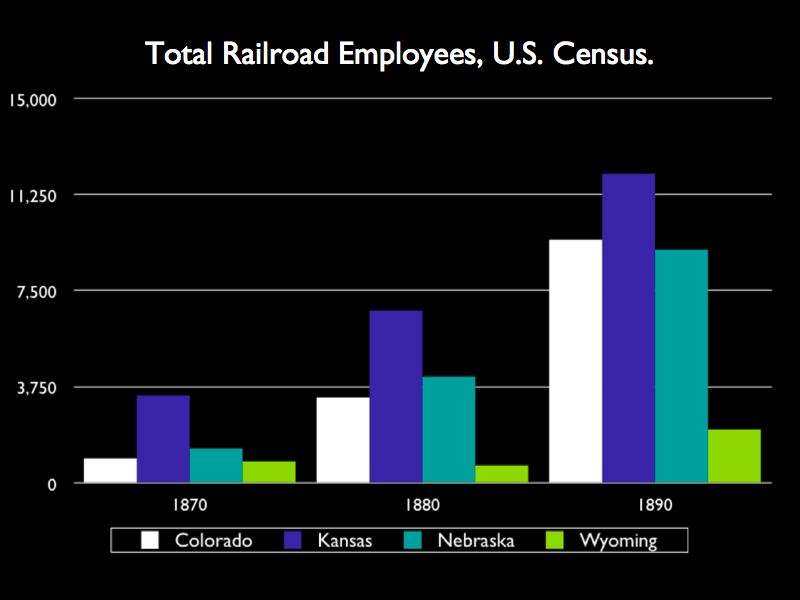Strikes, Blacklists, and Dismissals--Railroad Workers' Spatial History on the Great Plains
- Union Pacific Railroad Dismissals List
- Chicago, Burlington & Quincy Railroad Strike of 1888 Replacements
- Total Railroad Employees by state, 1870-1890
- Total Railroad Employees by state, 1870-1890 graph
- Rate of Increase in Railroad Employees, 1870-1890 Great Plains states
Total Railroad Employees by state, 1870-1890

Keywords
- Category: Animations
- Topic: Politics
- Topic: Labor
The most complete and detailed study of railroad worker mobility on the Great Plains has been Shelton Stromquist's A Generation of Boomers. He looked at the changes in labor mobility patterns between 1877 and 1894 and its effect on railroad workers' social and geographical mobility. He argued that railroad workers movements were largely defined by an east-to-west pattern, but, during the Burlington strike, the character of this pattern transitioned from voluntary to non-voluntary migration. Stromquist argued that in the first phase of railroad growth--the "generation of boomers"--was governed by the open market and the individual desire to move up in the industry. But this phase gradually drew to a close, because it was effaced by a regime of railroad company labor practices in the West, featuring the personal card system, blacklisting, promotion from within, company welfare policies, and the hiring strike breakers from other places. This series of company practices altered the railroad work environment which both shaped and was shaped by the strikes of the period.
Stromquist focused on how geographic and social mobility interlocked. He looked at two Iowa towns--Burlington and Crestone--and used a unique set of records to define railroad places. Iowa conducted a five-year census which collected detailed occupational information. Stromquist determined that there were twenty-four railroad towns in Iowa. He chose places only with more than 100 railroad employees based on this census, but these twenty-four towns contained 93 % of all railroad employees in the state. Stromquist then compared the individuals to their 1880 census data and was able, therefore, to determine ethnicity and age cohorts. He argued that Burlington was ten years younger than Crestone, and the age cohort of employees differed quite markedly. The result was a different response to the 1888 strike and the company practices in its aftermath. There are, however, few other states with such detailed censuses.
A great deal of evidence about railroad workers is contained in the short biographies recorded by the railroads of railroad dismissals and strike replacement hiring. Men moved in and out of railroad employment. They quit, they were dismissed, suspended, fired, rehired, quit, rehired again, and struck. They started in one position on the payroll and then moved to another. Sometimes they moved up and then back down. Railroad work was highly specific and diverse, and some of the occupational categories were flexible. A brakeman could quickly become a fireman if given the opportunity. This map shows the categories, places, and dates of the individual dismissals on the Union Pacific in a one year period.
